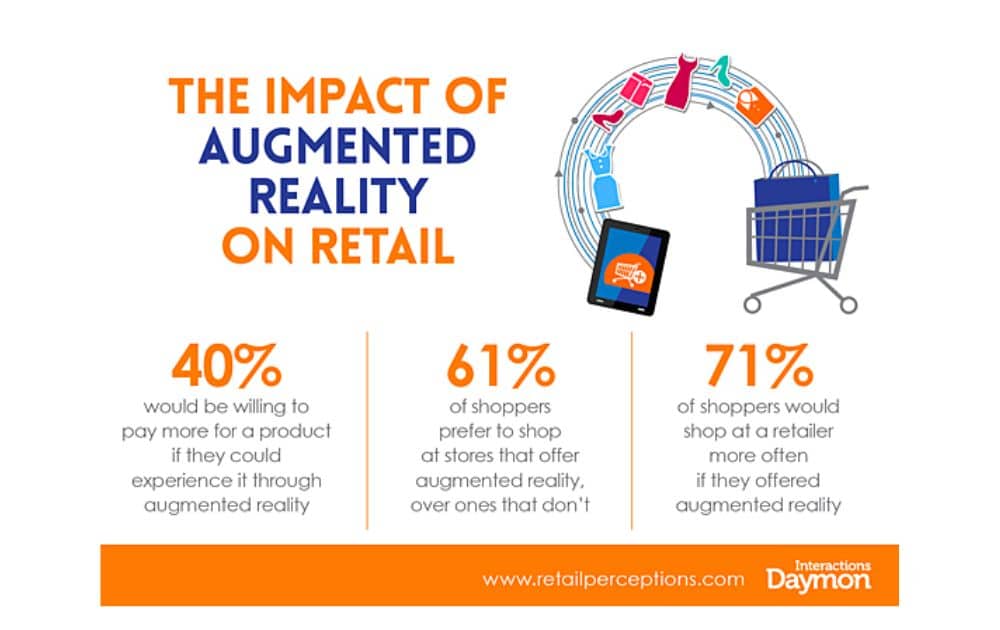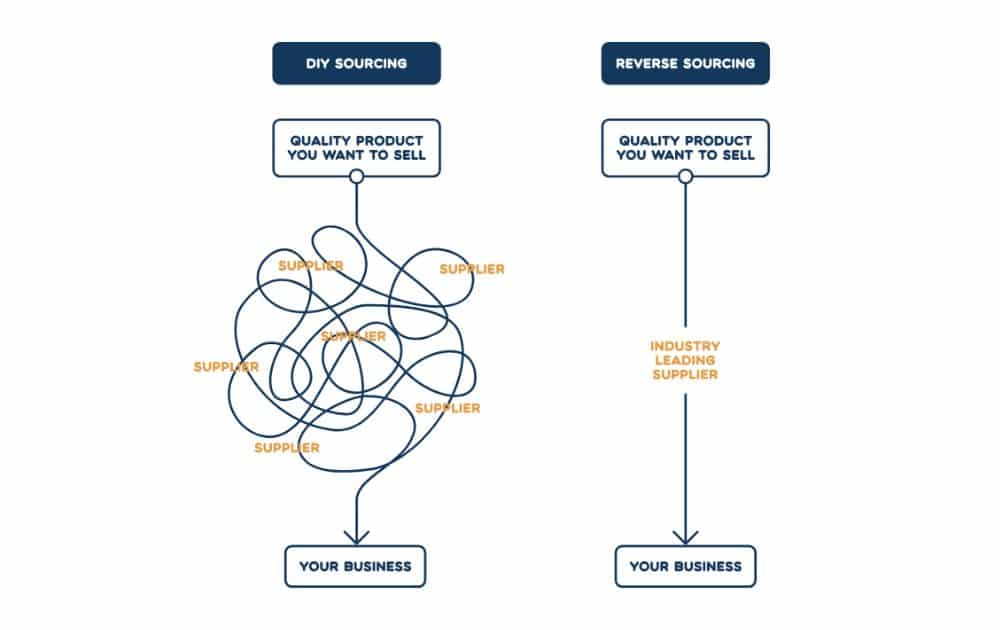Think of omnichannel eCommerce as a virtual marketplace without boundaries. Every click, swipe, and interaction is part of a symphony orchestrated to offer a seamless shopping experience.† In other words, digital savviness meets customer-centric innovation. And this is not...
Think of omnichannel eCommerce as a virtual marketplace without boundaries. Every click, swipe, and interaction is part of a symphony orchestrated to offer a seamless shopping experience.†
In other words, digital savviness meets customer-centric innovation. And this is not just the future of retail; itís the pulsating present, reshaping how sellers connect with their customers across multiple platforms.
According to data cited by Omnisend, campaigns utilizing only one channel experienced an order rate of 0.14% (calculated as the total orders divided by the total messages sent).†
In contrast, campaigns that incorporated three or more channels witnessed a significantly higher order rate of 0.83%, marking an impressive increase of 494%.
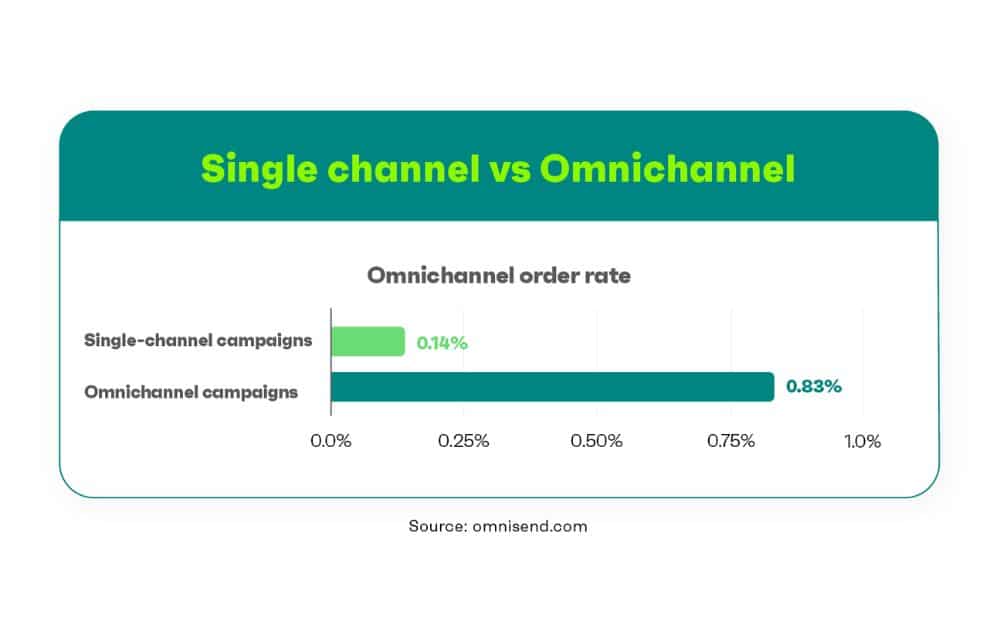 ingle-channel vs. Omnichannel (Source Ė Omnisend)
ingle-channel vs. Omnichannel (Source Ė Omnisend)
These numbers only show how omnichannel eCommerce can boost business growth if utilized correctly.
Letís discuss the components of this intricate network, revealing how itís not just changing the game but also setting new rules for customer engagement and business growth.
†
What is Omnichannel Ecommerce?
†
Omnichannel ecommerce is a comprehensive retail approach that integrates multiple shopping channels to provide a seamless and cohesive customer journey. For example: physical stores, online websites, social media, and mobile apps.
An omnichannel ecommerce strategy goes beyond simply operating across various platforms. It involves the deep integration of these channels, offering customers a consistent and unified brand experience regardless of how or where they choose to interact with the business.
Data from Grand View Research says the worldwide market for omnichannel retail solutions, which stood at a value of $5.96 billion in 2021, is projected to grow at a compound annual growth rate of 13.6% from 2022 to 2030.
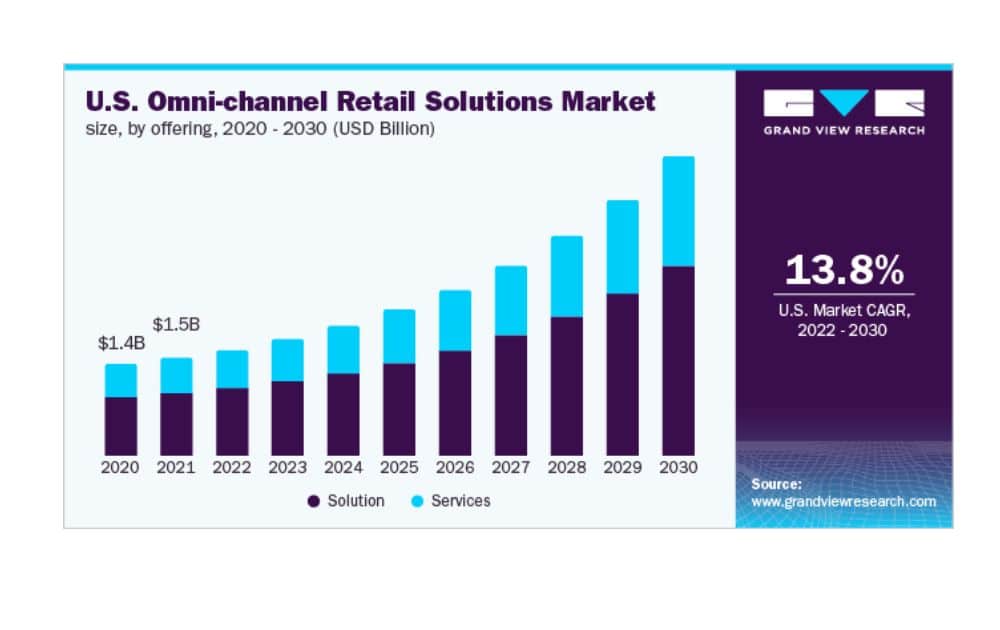 US Omnichannel Retail Solutions Market (Source Ė Grand View Research)
US Omnichannel Retail Solutions Market (Source Ė Grand View Research)
Factors fueling the growth of the market include:
Growing need for centralized data management The rising trend of transforming traditional businesses into eCommerce platforms Advantages offered by omnichannel analytics†
Omnichannel vs. Multichannel Ecommerce
†
By definition, multichannel eCommerce refers to the use of multiple channels for selling products or services, but these channels often operate independently. This could include a combination of physical stores, online websites, social media platforms, and mobile apps.
In comparison, omnichannel ecommerce takes a more integrated approach. It involves selling across multiple channels, and it also focuses on creating a seamless and consistent experience across these platforms.
†
The Benefits of Omnichannel Ecommerce
†
This approach, which integrates an omniChannel ecommerce platform with various sales channels, leads to a more dynamic and responsive retail environment. Here are some key benefits:
†
Enhanced Customer Experience
†
Omnichannel ecommerce excels in providing a unified customer experience. Whether a customer is shopping online from a desktop, browsing through a mobile app, or visiting a physical store, the experience remains consistent and seamless.†
This consistency builds trust and improves customer satisfaction.
†
Increased Sales and Customer Loyalty
†
Implementing an omnichannel strategy can lead to a significant rise in sales. As observed, campaigns with a multichannel strategy outperform single-channel campaigns dramatically.†
This effort further feeds the flywheel cyclical success, leading to increased customer retention and higher sales.
†
Data-driven Insights for Personalization
†
Omnichannel strategies allow for customer data integration from multiple touchpoints. This data is crucial for understanding customer preferences and behaviors, enabling businesses to tailor their offerings and marketing efforts for a more personalized shopping experience.†
†
Higher Customer Purchase Frequency
†
Data cited by Digizuite says campaigns employing at least three channels can achieve a purchase rate that is 287% greater than campaigns restricted to just one channel.†
Additionally, the frequency of customer purchases on omnichannel platforms is 250% greater compared to single-channel systems.
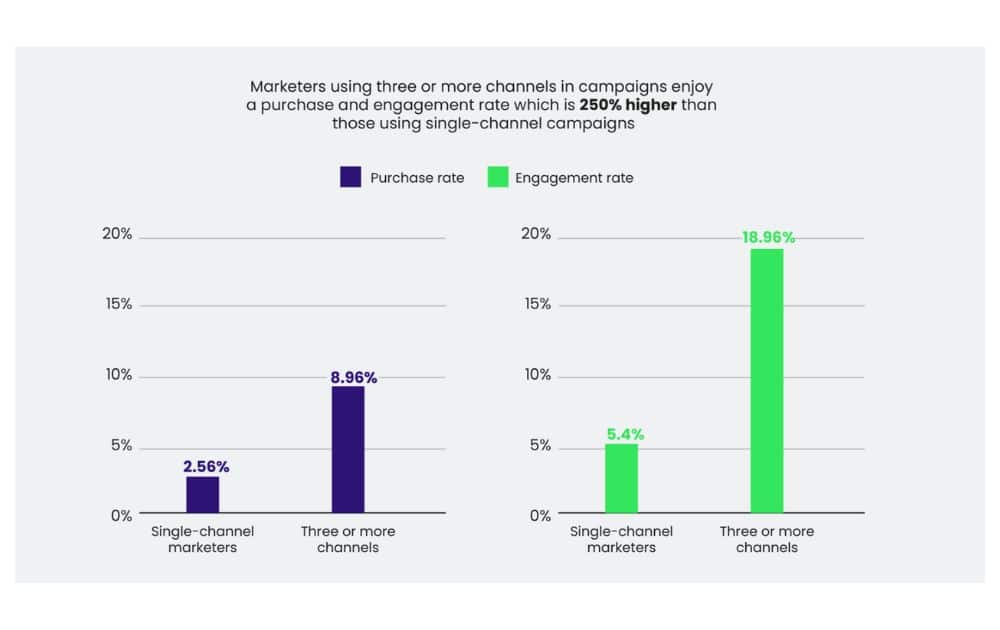 Single-Channel vs. Multiple-Channel Marketing (Source Ė Digizuite)
Single-Channel vs. Multiple-Channel Marketing (Source Ė Digizuite)
These numbers only prove that customer purchase frequency is significantly higher in omnichannel systems compared to single-channel setups.†
This increase is attributed to the convenience and personalized experiences that omnichannel strategies provide, encouraging customers to engage more frequently.
†
Competitive Advantage
†
With todayís digital channels, an omnichannel ecommerce strategy is not just a luxury but a necessity. This approach is instrumental for businesses aiming to avoid common pitfalls, aligning with the top 10 common ecommerce mistakes to avoid.†
It positions ventures at the forefront of market trends, ensuring they meet and exceed customer expectations for smooth, integrated shopping experiences.
†
What is an Example of an Omnichannel Commerce?
†
Amazonís implementation of omnichannel marketing strategies is a prime example of seamlessly integrating various shopping channels and customer touchpoints to create a cohesive and efficient shopping experience. Hereís how Amazon achieves this:
†
Unified Online and Physical Presence
†
Amazon has expanded beyond its online platform to include physical stores, such as Amazon Go, Amazon Books, and Whole Foods Market.†
These stores are integrated with Amazonís omnichannel ecommerce platform, allowing for a seamless transition between online and offline shopping.
Amazonís foray into brick-and-mortar retail proves to be a good move. In 2022, the revenue generated from Amazonís physical retail operations approached nearly $19 billion.
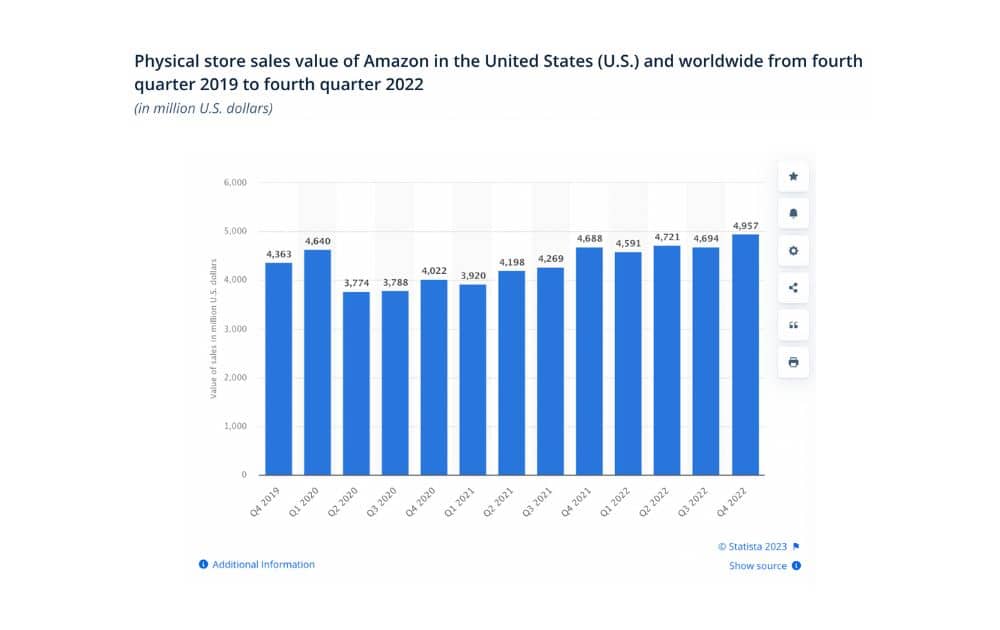 Physical store sales value of Amazon in the US (Statista)
Physical store sales value of Amazon in the US (Statista)
Mobile Integration
†
Amazonís mobile app is closely integrated with its online platform, offering features like barcode scanning in physical stores, voice shopping with Alexa, and easy access to account and order information, enhancing the mobile shopping experience.
†
Voice Shopping with Alexa
†
Amazon has leveraged its voice assistant, Alexa, to create a unique omnichannel ecommerce channel. Customers can use voice commands to search for products, place orders, and track deliveries, integrating voice eCommerce into customer satisfaction.
†
Amazon Lockers
†
To bridge the gap between online purchasing and physical delivery, Amazon introduced lockers in various locations where customers can pick up their orders at their convenience. This service provides a flexible delivery option, integrating online shopping with physical pickup points.
†
Amazon Marketplace
†
The integration of third-party sellers into Amazonís platform is another aspect of its omnichannel strategy. The marketplace allows customers to shop from a wide range of vendors within the Amazon ecosystem, providing a diverse and comprehensive shopping experience.
†
Amazon Web Services (AWS)
†
While primarily a cloud computing service, AWS supports the vast data infrastructure required for omnichannel operations, ensuring that all of Amazonís services run smoothly and are well-integrated.
†
Developing an Omnichannel Ecommerce Strategy
†
Crafting a successful omnichannel ecommerce strategy involves several key steps and considerations to ensure a seamless integration of all sales channels and a superior customer experience.
†
Hereís a guide to developing an effective omnichannel strategy:
†
Understand the Customerís Journey
†
Map out the customer journey across all channels. Start by listing all the possible points of interaction your customers have with your brand, including:
Online platforms (website, mobile app) Social media Email Physical stores Customer service, and more.†
Itís also vital to use data analytics to gain insights into customer behavior and preferences. Look for patterns in how different customer segments interact with your channels. Are there certain products that drive more online engagement? Do some customers prefer in-store experiences?
Related content: Creating an Amazon Sales Funnel
†
Select the Right Omnichannel Ecommerce Platform
†
Choose a platform that supports omnichannel integration and allows a unified view of inventory, sales, and customer interactions.
As you choose among many options, ensure that your platform can integrate with existing systems like CRM, ERP, and POS for seamless data flow.
†
Leverage Technology for Personalization
†
Utilize technology to offer personalized experiences based on customer data. These experiences could include:
Personalized product recommendations Targeted marketing campaigns Customized contentYou can also consider advanced technologies like AI and machine learning for deeper personalization.
†
Focus on Customer Data Integration
†
Implement systems that collect and analyze data from all channels, including the Amazon Insights Program, if youíre selling on the marketplace.
This integrated data is key to understanding customer needs and improving their shopping experience.†
As you focus on data integration, however, itís crucial to respect customer privacy and comply with data protection regulations. Otherwise, you might compromise your reputation as a business.
†
Streamline Inventory and Supply Chain Management
†
Adopt an integrated approach to manage inventory across all channels. This may include real-time inventory updates, which are crucial to avoid overstocking or stockouts. In addition, ensure efficient supply chain management ensures product availability and timely delivery.
Related content: Inventory Performance Index
†
Measure and Adapt
†
Continuously monitor the performance of your omnichannel strategy using key performance indicators like:
Customer satisfaction Sales conversion rates, and Channel effectivenessBe prepared to adapt and evolve your strategy based on feedback and changing market trends.
Related content: Amazon Reports
†
Embracing the Future with Omnichannel Ecommerce
†
As we journey through the dynamic landscape of omnichannel ecommerce, itís clear that this approach is not just a fleeting trend but a fundamental shift in the retail industry.†
Those who embrace the omnichannel approach will be well-positioned to lead the charge into a future where the lines between physical and digital shopping are not just blurred but harmoniously intertwined.
†
Author
 Carla Bauto DeŮa is a journalist and content writer producing stories for traditional and digital media. She believes in empowering small businesses with the help of innovative solutions, such as eCommerce, digital marketing, and data analytics.
Carla Bauto DeŮa is a journalist and content writer producing stories for traditional and digital media. She believes in empowering small businesses with the help of innovative solutions, such as eCommerce, digital marketing, and data analytics.
The post Inside Omnichannel Ecommerce appeared first on AMZ Advisers.






